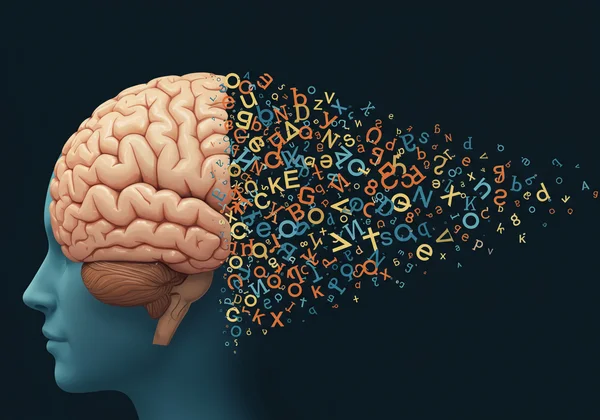Signs of Dyslexia: When to Take a Dyslexia Screening
Watching your bright child struggle with reading, or feeling a lifelong frustration with words yourself, can be confusing and isolating. You find yourself constantly wondering, "Could this be dyslexia?" This question is the first step on a path to understanding. This article will provide clarity by outlining 10 key signs across different age groups, helping you take that crucial first step toward support and empowerment. A preliminary dyslexia test can offer valuable initial insights and guide your next actions.
Recognizing the signs is not about labeling; it's about unlocking potential. Dyslexia is a common learning difference that affects the way the brain processes written and spoken language. It has nothing to do with intelligence. By understanding the clues, you can begin to find the right strategies and tools to help yourself or your child thrive. If you're looking for answers, a simple online screening can be a great place to start.

Early Signs of Dyslexia in Children
For concerned parents, identifying potential signs of dyslexia early can make a significant difference in a child's educational journey. These clues often appear long before formal reading instruction begins and can evolve as the child gets older. Paying attention to these developmental markers is key.
In Preschoolers (Ages 3-5)
Even in the earliest years, subtle clues can emerge. These signs often relate to the foundational skills of language development, which are the building blocks for reading.
- 1. Trouble with Nursery Rhymes: A persistent difficulty learning or remembering nursery rhymes can be an early indicator. This points to challenges with phonological awareness—the ability to recognize and work with the sounds in spoken language.
- 2. Mispronouncing Familiar Words: While all young children make speech errors, a child with potential dyslexia might frequently mispronounce words (e.g., saying "pasghetti" for spaghetti) or confuse words that sound alike. This is often described as trouble with pronouncing words.
- 3. Difficulty Recognizing Letters: Many preschoolers can recognize the letters in their own name. A child who consistently struggles with this, despite repeated exposure, might be showing an early sign.
In School-Aged Children (Ages 6-12)
As academic demands increase, the signs of dyslexia often become more apparent. The challenges are most visible in reading, spelling, and writing tasks.
-
4. Difficulty Decoding Words: This is a classic sign. The child may struggle to sound out new words, guessing based on the first letter or a picture instead of applying phonetic rules. This leads to slow or choppy reading.
-
5. Poor Spelling: Spelling can be a major hurdle. You might notice inconsistent spelling of the same word, letters out of order, or phonetic spellings that are hard to decipher (e.g., "sed" for said).
-
6. Confusing Letters and Numbers: A common and well-known sign is the persistent reversal of letters like 'b' and 'd' or numbers like '6' and '9' long after their peers have mastered them. This is often linked to confusing letters b/d.
-
7. Avoiding Reading Aloud: Children who find reading difficult will often go to great lengths to avoid it, especially reading aloud in class. They may complain of headaches or stomachaches when it's time to read to evade the stressful experience. Getting a clearer picture with a dyslexia test for kids can provide a basis for conversations with their teacher.

Beyond Reading: The Hidden Signs
Dyslexia's impact is not limited to reading and writing. It can also affect other areas of organization and memory.
- 8. Trouble with Sequences: A child might have difficulty remembering sequences, such as the days of the week, the months of the year, or the alphabet in order. This reflects challenges with working memory and sequencing.
- 9. Difficulty with Left and Right: A persistent confusion between left and right that continues beyond the age of 7 or 8 can be another subtle indicator related to how the brain processes spatial information.
Recognizing Signs of Dyslexia in Adults
Many adults have navigated school and careers without ever receiving a diagnosis, privately struggling with tasks that seem effortless for others. Recognizing the signs in yourself can be a validating and empowering experience, providing an explanation for long-held challenges. An online dyslexia test can be a private, low-pressure way to explore these possibilities.
Persistent Reading and Writing Challenges
The difficulties experienced in childhood often persist into adulthood, though many individuals develop sophisticated coping mechanisms to mask them.
- 10. Slow Reading and Comprehension Issues: You might find yourself reading slowly and needing to re-read sentences or paragraphs multiple times to grasp their meaning. You might also avoid reading for pleasure or find that reading long documents for work is mentally exhausting.
- Avoiding Writing Tasks: Do you dread writing emails or reports? Adults with dyslexia often have persistent spelling difficulties and struggle to organize their thoughts on paper, leading them to avoid writing tasks whenever possible.
Impacts on Work and Daily Life
The effects of undiagnosed dyslexia can ripple through daily life and professional performance, often causing stress and self-doubt.
-
Difficulty with Time Management: Challenges with sequencing can translate into difficulty with time management and organization. You might struggle to meet deadlines or estimate how long a task will take.
-
Workplace Anxiety: The constant effort required to keep up with reading- and writing-intensive tasks can lead to significant workplace anxiety. You may live in fear of being "found out" or feel like an imposter despite your skills and intelligence. Taking an am I dyslexic quiz could be the first step toward self-understanding and finding better strategies.

What to Do If You Recognize These Signs
If these signs resonate with you, whether for your child or yourself, it's important to remember that this is a moment for clarity, not fear. Recognizing the signs is the first step. The next step is gathering more information in a structured way.
Why a Dyslexia Screening is a Vital First Step
A formal diagnostic assessment for dyslexia can be a lengthy and expensive process. A dyslexia screening serves as an essential preliminary step. It is a tool designed to quickly and efficiently identify whether an individual exhibits a pattern of strengths and weaknesses consistent with a risk for dyslexia. It provides data-driven insights that can help you decide on the next course of action, such as speaking with a teacher or seeking a full evaluation.
Take a Free Online Dyslexia Test for Initial Insights
The journey to understanding begins with a single, simple action. A free online dyslexia test is designed to give you immediate, confidential feedback. Our 12-question screening, developed by educational psychologists and dyslexia researchers, assesses key areas like phonological processing, decoding, and spelling. It provides a risk index (low, medium, high) and actionable advice, empowering you with the knowledge to move forward. Get initial insights in just a few minutes.

Your Path to Clarity Starts With a Single Step
Recognizing the signs of dyslexia in yourself or your child is a pivotal moment. It’s the end of confusion and the beginning of understanding. These signs are not a verdict but a guide, pointing toward a different way of learning and thinking that comes with its own unique strengths, like creativity and problem-solving. The most important thing is to take action.
Don't let uncertainty hold you or your child back any longer. Information is power, and clarity is the key to unlocking true potential. By understanding the challenges, you can find the right support and strategies to succeed.
Ready to take the next step on your journey? Take our free test now and get the confidential insights you need to move forward with confidence.
Frequently Asked Questions About Dyslexia
How do you test for dyslexia?
Testing for dyslexia typically involves two stages. The first is often a screening, like the one offered on our site. A screening is a brief tool that identifies potential risk. If a screening indicates a high risk, the next step is a formal diagnostic assessment conducted by a qualified professional, such as an educational psychologist. This comprehensive evaluation provides a definitive diagnosis.
What are the main signs of dyslexia in a 7-year-old?
In a 7-year-old, the main signs of dyslexia are often related to early academic tasks. These include significant difficulty sounding out words, slow and effortful reading, persistent confusion with letters like 'b' and 'd', poor spelling, and a strong reluctance to read. They might also struggle to remember sight words or have trouble connecting letters to their sounds.
Is an online dyslexia test accurate?
It's crucial to understand the difference between a screening and a diagnosis. An online dyslexia test like ours is a highly reliable screening tool. It is designed to accurately identify individuals who are at risk for dyslexia. However, it cannot provide a formal clinical diagnosis. Its accuracy lies in its ability to be a strong first indicator, guiding you on whether to pursue a full professional evaluation. Our online test is a trustworthy starting point.
Can a smart person have dyslexia?
Absolutely. This is one of the most important facts to understand about dyslexia. Dyslexia is a learning difference related to language processing; it is completely unrelated to a person's intelligence. Many of the world's most brilliant and successful people—including entrepreneurs, artists, and scientists—have dyslexia. Their minds simply work differently.